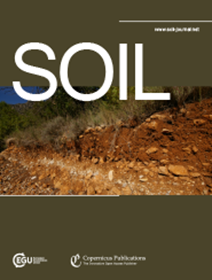土壤的通气性和矿物组成调节微生物CUE
IF 4.3
2区 农林科学
Q1 SOIL SCIENCE
引用次数: 0
摘要
摘要。在生态系统研究中,微生物碳利用效率(CUE)经常被用来估计微生物生物量消耗的有机底物(葡萄糖)的比例,这些有机底物(葡萄糖)没有以二氧化碳的形式从土壤中释放出来。虽然大多数研究假设好氧条件,二氧化碳和微生物生物量是有机基质处理的主要产物,但缺氧微生境在土壤团聚体中很常见。这些微生态中的微生物利用替代电子受体进行发酵和厌氧呼吸:与细胞外中间体释放有关的过程。这些细胞外中间体和其他化合物传统上不被考虑在内,但与微生物生物量形成相比,它们可能代表着重要的碳通量。气候变化可能通过改变局部水平的土壤通气状况来调节土壤微生物活动。因此,CUE作为生态系统研究和建模中使用的一个内在参数,应该定义为关于土壤通气性的更现实的假设。本文主要研究了氧和铁的有效性对森林土壤碳矿化的影响,以及生物量和不同细胞外代谢物之间碳的定量分布。选取捷克两个波西米亚森林(Bohemian Forest, Czechia)试验点的低铁和高铁土壤,在缺氧和缺氧条件下进行培养。13c标记的葡萄糖溶液用于跟踪C在生物质、呼吸二氧化碳和细胞外代谢物中的掺入。我们根据测量的累积微生物呼吸、剩余葡萄糖、生物量和细胞外代谢物浓度来估计CUE。采用RNA-SIP对各处理下的活性菌进行鉴定。在缺氧条件下,葡萄糖被迅速消耗并大量转化为二氧化碳,与高铁土壤相比,低铁土壤中微生物量和CUE更大。在缺氧条件下,葡萄糖消耗较慢,导致发酵产物积累,特别是在高铁土壤中,碳储存效率更高。在缺氧条件下,微生物的生长和周转普遍较低。在缺氧条件下,大量不同的微生物群落迅速吸收了13c标记的葡萄糖,鉴定出300多种活性扩增子序列变异(asv),主要来自优势门,如变形菌门、放线菌门和拟杆菌门。相比之下,缺氧条件导致标记速度慢得多且更有限,只有少数asv(主要是厚壁菌门)含有13C。我们的研究结果证实,土壤中的缺氧增强了短期的碳保存,并表明在质量通量计算中排除渗出物会低估土壤中的碳保留,特别是在缺氧条件下。本文章由计算机程序翻译,如有差异,请以英文原文为准。
Aeration and mineral composition of soil mediate microbial CUE
Abstract. In ecosystem studies, microbial carbon use efficiency (CUE) is often used to estimate the proportion of organic substrate (glucose) consumed by microbial biomass that is not released from soil as CO2. While most studies assume aerobic conditions, with CO2 and microbial biomass as the predominant products of organic substrate processing, anoxic microniches are common inside soil aggregates. Microorganisms in these microniches perform fermentation and anaerobic respiration using alternative electron acceptors: processes connected with the release of extracellular intermediates. These extracellular intermediates and other compounds are not traditionally accounted for but may represent a significant C flux when compared to microbial biomass formation. Climate change may modulate soil microbial activity by altering soil aeration status on a local level. Therefore, CUE as an intrinsic parameter that is used in ecosystem studies and modelling should be defined for more realistic assumptions regarding soil aeration. This study focused on the effect of oxygen and Fe availability on C mineralisation in forest soils and quantified C distribution between biomass and different extracellular metabolites. Forest soils from two Bohemian Forest (Czechia) sites, with low and high Fe content, were incubated under oxic and anoxic conditions. A solution of 13C-labelled glucose was used to track C incorporation into the biomass, respired CO2, and extracellular metabolites. We estimated CUE based on measured cumulative microbial respiration, residual glucose, biomass, and extracellular metabolites concentration. RNA-SIP was used to identify the active bacteria under each treatment. Under oxic conditions, glucose was rapidly consumed and largely converted to CO2, with greater microbial biomass and CUE observed in the low-Fe soil compared to the high-Fe soil. In contrast, under anoxic conditions, glucose consumption was slower, leading to the accumulation of fermentation products, especially in the high-Fe soil, and higher carbon storage efficiency. Microbial growth and turnover were generally lower under anoxic conditions. A large and diverse portion of the microbial community rapidly incorporated 13C-labelled glucose under oxic conditions, with over 300 active amplicon sequence variants (ASVs) identified – primarily from dominant phyla like Proteobacteria, Actinomycetota, and Bacteroidota. In contrast, anoxic conditions led to much slower and more limited labelling, with only a few ASVs (mainly Firmicutes) incorporating 13C. Our findings confirm that anoxia in soils enhances short-term C preservation and suggest that excluding exudates in mass flux calculations would underestimate C retention in the soil, especially under anoxic conditions.
求助全文
通过发布文献求助,成功后即可免费获取论文全文。
去求助
来源期刊

Soil
Agricultural and Biological Sciences-Soil Science
CiteScore
10.80
自引率
2.90%
发文量
44
审稿时长
30 weeks
期刊介绍:
SOIL is an international scientific journal dedicated to the publication and discussion of high-quality research in the field of soil system sciences.
SOIL is at the interface between the atmosphere, lithosphere, hydrosphere, and biosphere. SOIL publishes scientific research that contributes to understanding the soil system and its interaction with humans and the entire Earth system. The scope of the journal includes all topics that fall within the study of soil science as a discipline, with an emphasis on studies that integrate soil science with other sciences (hydrology, agronomy, socio-economics, health sciences, atmospheric sciences, etc.).
 求助内容:
求助内容: 应助结果提醒方式:
应助结果提醒方式:


